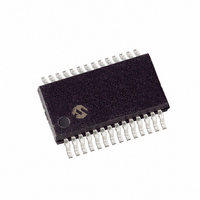PIC18F25J10-I/SS Microchip Technology, PIC18F25J10-I/SS Datasheet - Page 164

PIC18F25J10-I/SS
Manufacturer Part Number
PIC18F25J10-I/SS
Description
IC PIC MCU FLASH 16KX16 28SSOP
Manufacturer
Microchip Technology
Series
PIC® 18Fr
Datasheets
1.PIC16F616T-ISL.pdf
(8 pages)
2.PIC18F24J10-ISO.pdf
(368 pages)
3.PIC18F24J10-ISO.pdf
(6 pages)
4.PIC18F24J10-ISO.pdf
(6 pages)
5.PIC18F24J10-ISO.pdf
(12 pages)
6.PIC18LF24J10-ISS.pdf
(32 pages)
7.PIC18F45J10-IPT.pdf
(362 pages)
Specifications of PIC18F25J10-I/SS
Core Size
8-Bit
Program Memory Size
32KB (16K x 16)
Peripherals
Brown-out Detect/Reset, POR, PWM, WDT
Core Processor
PIC
Speed
40MHz
Connectivity
I²C, SPI, UART/USART
Number Of I /o
21
Program Memory Type
FLASH
Ram Size
1K x 8
Voltage - Supply (vcc/vdd)
2.7 V ~ 3.6 V
Data Converters
A/D 10x10b
Oscillator Type
Internal
Operating Temperature
-40°C ~ 85°C
Package / Case
28-SSOP
Controller Family/series
PIC18
No. Of I/o's
21
Ram Memory Size
1KB
Cpu Speed
40MHz
No. Of Timers
3
Processor Series
PIC18F
Core
PIC
Data Bus Width
8 bit
Data Ram Size
1 KB
Interface Type
SPIC, I2C, EUSART
Maximum Clock Frequency
40 MHz
Number Of Programmable I/os
21
Number Of Timers
3
Maximum Operating Temperature
+ 85 C
Mounting Style
SMD/SMT
3rd Party Development Tools
52715-96, 52716-328, 52717-734, 52712-325, EWPIC18
Development Tools By Supplier
PG164130, DV164035, DV244005, DV164005, PG164120, DM183022, DM183032, DV164136
Minimum Operating Temperature
- 40 C
On-chip Adc
10 bit, 10 Channel
Package
28SSOP
Device Core
PIC
Family Name
PIC18
Maximum Speed
40 MHz
Operating Supply Voltage
5 V
Lead Free Status / RoHS Status
Lead free / RoHS Compliant
For Use With
AC162074 - HEADER INTRFC MPLAB ICD2 44TQFPMA180011 - MODULE PLUG-IN 18F25J10 28SOICAC162067 - HEADER INTRFC MPLAB ICD2 40/28PAC164331 - MODULE SKT FOR 28SSOP 18F45J10XLT28SS-1 - SOCKET TRANSITION ICE 28SSOP
Eeprom Size
-
Lead Free Status / Rohs Status
Details
Available stocks
Company
Part Number
Manufacturer
Quantity
Price
Part Number:
PIC18F25J10-I/SS
Manufacturer:
MICROCHIP/微芯
Quantity:
20 000
- PIC16F616T-ISL PDF datasheet
- PIC18F24J10-ISO PDF datasheet #2
- PIC18F24J10-ISO PDF datasheet #3
- PIC18F24J10-ISO PDF datasheet #4
- PIC18F24J10-ISO PDF datasheet #5
- PIC18LF24J10-ISS PDF datasheet #6
- PIC18F45J10-IPT PDF datasheet #7
- Current page: 164 of 362
- Download datasheet (6Mb)
PIC18F45J10 FAMILY
15.4.3.3
When the R/W bit of the address byte is clear and an
address match occurs, the R/W bit of the SSPxSTAT
register is cleared. The received address is loaded into
the SSPxBUF register and the SDAx line is held low
(ACK).
When the address byte overflow condition exists, then
the no Acknowledge (ACK) pulse is given. An overflow
condition is defined as either bit, BF (SSPxSTAT<0>),
is set, or bit, SSPOV (SSPxCON1<6>), is set.
An MSSP interrupt is generated for each data transfer
byte. The interrupt flag bit, SSPxIF, must be cleared in
software. The SSPxSTAT register is used to determine
the status of the byte.
If SEN is enabled (SSPxCON2<0> = 1), SCKx/SCLx
(RC3 or RD0) will be held low (clock stretch) following
each data transfer. The clock must be released by
setting bit, CKP (SSPxCON1<4>). See Section 15.4.4
“Clock Stretching” for more details.
DS39682D-page 162
Reception
15.4.3.4
When the R/W bit of the incoming address byte is set
and an address match occurs, the R/W bit of the
SSPxSTAT register is set. The received address is
loaded into the SSPxBUF register. The ACK pulse will
be sent on the ninth bit and pin RC3 or RD6 is held low,
regardless of SEN (see Section 15.4.4 “Clock
Stretching” for more details). By stretching the clock,
the master will be unable to assert another clock pulse
until the slave is done preparing the transmit data. The
transmit data must be loaded into the SSPxBUF regis-
ter which also loads the SSPxSR register. Then pin
RC3 or RD0 should be enabled by setting bit, CKP
(SSPxCON1<4>). The eight data bits are shifted out on
the falling edge of the SCLx input. This ensures that the
SDAx signal is valid during the SCLx high time
(Figure 15-9).
The ACK pulse from the master-receiver is latched on
the rising edge of the ninth SCLx input pulse. If the
SDAx line is high (not ACK), then the data transfer is
complete. In this case, when the ACK is latched by the
slave, the slave logic is reset (resets SSPxSTAT
register) and the slave monitors for another occurrence
of the Start bit. If the SDAx line was low (ACK), the next
transmit data must be loaded into the SSPxBUF regis-
ter. Again, pin RC3 or RD0 must be enabled by setting
bit CKP.
An MSSP interrupt is generated for each data transfer
byte. The SSPxIF bit must be cleared in software and
the SSPxSTAT register is used to determine the status
of the byte. The SSPxIF bit is set on the falling edge of
the ninth clock pulse.
Transmission
© 2008 Microchip Technology Inc.
Related parts for PIC18F25J10-I/SS
Image
Part Number
Description
Manufacturer
Datasheet
Request
R

Part Number:
Description:
Manufacturer:
Microchip Technology Inc.
Datasheet:

Part Number:
Description:
Manufacturer:
Microchip Technology Inc.
Datasheet:

Part Number:
Description:
Manufacturer:
Microchip Technology Inc.
Datasheet:

Part Number:
Description:
Manufacturer:
Microchip Technology Inc.
Datasheet:

Part Number:
Description:
Manufacturer:
Microchip Technology Inc.
Datasheet:

Part Number:
Description:
Manufacturer:
Microchip Technology Inc.
Datasheet:

Part Number:
Description:
Manufacturer:
Microchip Technology Inc.
Datasheet:

Part Number:
Description:
Manufacturer:
Microchip Technology Inc.
Datasheet:











